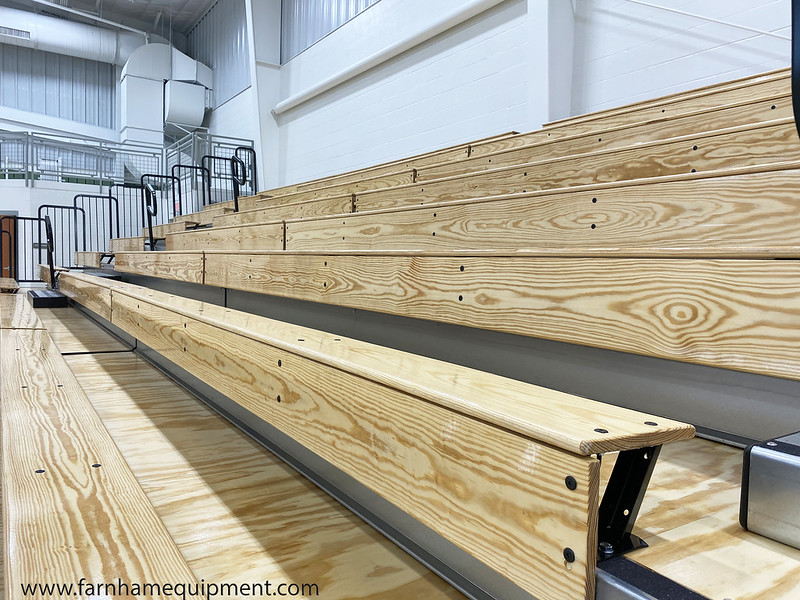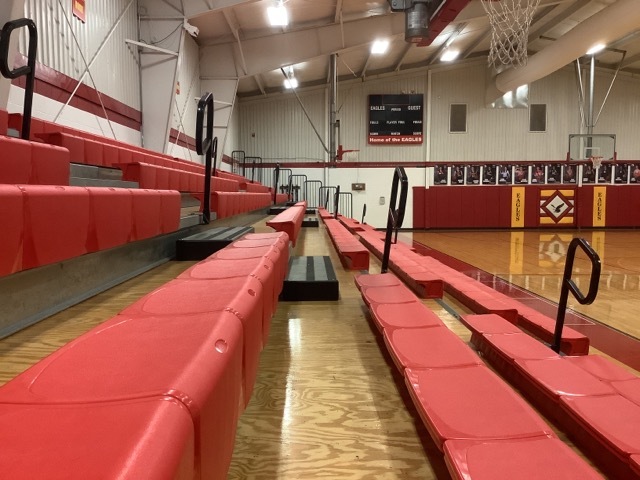The most common violation, and perhaps the easiest to spot, involves a 4-inch sphere. Why a 4-inch sphere? Think about the members of the community in your bleachers or your grandstands watching the game. Even the tiniest of fans come out to support their big brothers or big sisters. The guidelines behind the 4-inch sphere space allowance were put in place to prevent babies and toddlers from falling through. It has also been proven that some school age children can fit through an opening that is less than 6”. This is the reason that the sphere size to prohibit passage was reduced from 6” to 4”. The elimination of a gap bigger than 4 inches also prevents someone from tripping, falling, or getting stuck in the gap.
Last spring, a settlement was reached and approved for a local school district in Toppenish, Washington for an accident that happened in 2007. The $6.9 million dollar settlement was awarded to the family of an infant, now six years old, which fell through a 7.5-inch gap in the bleachers during a soccer game. At the time, the infant’s baby sitter was preparing to buckle her into a car seat when the seat fell off the bleachers and the infant tumbled out falling 13 feet below onto the cement surface. The baby was hospitalized for almost a month undergoing numerous surgeries and now faces several disabilities including no functional use of her left arm and leg, no control over her bowel and bladder, and cannot walk.
The bleachers were installed in 1960 and at the time were code compliant. Since then however, several provisions have been adopted and the most recent, in accordance with the accident, was adopted in the city of Toppenish in 2004 but not enforced within the district. This ICC code indicated that all gaps in bleachers must prohibit the passage of a 4-inch sphere.
According to several news sources, the district continues to deny liability for the incident, calling it an “unfortunate accident” and stating that the standards were part of an “obscure international law.”
After the settlement, the school district made plans to replace the bleachers in their district to be code compliant and safe for their community patrons – a full six years after the incident.
Some people have argued that this accident could have been prevented had the babysitter or parents been watching the infant more carefully. That the fault isn’t with the school district but the care providers. Some also argue that bleachers have had gaps in them since the 1960s and they survived. But as with all laws and building codes, they were created and implemented because of the danger and threat not having them in place causes. If you read back to our statistics and history of the International Building Code, you’ll notice an alarming number of incidents that can now be prevented with code compliance. The reality is, had the district been in compliance with the building standards and provisions in their community, this child would be walking today.
Looking at the ICC 300-2012, the first place you will find mention of a 4-inch sphere is in Chapter 3 Construction, Section 311.1:
 Open spaces at footboards and seatboards. Where an opening between the seatboard and the footboard is located more than 30 inches (762 mm) above the floor or ground below, the opening shall be closed with construction such that a 4-inch-diameter (102 mm) sphere cannot pass through.
Open spaces at footboards and seatboards. Where an opening between the seatboard and the footboard is located more than 30 inches (762 mm) above the floor or ground below, the opening shall be closed with construction such that a 4-inch-diameter (102 mm) sphere cannot pass through.
And again in Chapter 4 Egress, Section 408.2:
Opening limitations: Open guards shall be constructed of materials such that a 4-inch-diameter (102 mm) sphere cannot pass through any opening up to a height of 34 inches (864 mm). From the height of 34 inches (864) to 42 inches (1067 mm) above the adjacent walking surfaces, a sphere 8 inches (203 mm) in diameter shall not pass.
But there are exceptions:
- 1. The triangular opening formed by the riser, tread and bottom rail at the open side of an aisle stair or tiered seating shall be a maximum size such that a sphere of 6 inches (152 mm) in diameter cannot pass through the opening.
- 2. Guards at the end of aisles where they terminate at a fascia of boxes, balconies and galleries shall have balusters or ornamental patterns such that a 4-inch-diameter (102 mm) sphere cannot pass through any opening up to a height of 26 inches (660 mm). From a height of 26 inches (660 mm) or greater above the adjacent walking surfaces, a sphere 8 inches (203 mm) in diameter shall not pass.
Remember, Chapters 3 and 4 apply to new installations. Chapter 5 Existing Bleachers, Folding and Telescopic Seating, and Grandstands, Section 503.2 states:
 Opening limitations: Open guards shall be constructed of materials such that a 4-inch diameter (102 mm) sphere cannot pass through any opening.
Opening limitations: Open guards shall be constructed of materials such that a 4-inch diameter (102 mm) sphere cannot pass through any opening.
Exception: The triangular opening formed by the riser, tread and bottom rail at the open side of an aisle stair or tiered seating shall be a maximum size such that a sphere of 6 inches (152 mm) in diameter cannot pass through the opening.
Section 504.1 addresses Open spaces at footboards and seatboards:
Where an opening between the seatboard and the footboard is located more than 30 inches (762 mm) above the floor or ground below, the opening shall be closed with construction such that a 4-inch-diameter (102 mm) sphere cannot pass through.
Exception: Where the uppermost seat is located less than or equal to 55 inches (1397 mm) above the floor or ground below.
For safety and code compliance, it’s recommended that all existing facilities follow the 4-inch sphere rule. In the case of outdoor bleachers, the most common form of closing the 4-inch gap with guardrails is to install fencing along the rails. When doing this, you have to be sure to also follow the code compliance load requirements – ability to withstand a 200lb concentrated load – to be sure that the gaps are in fact closed off. You will also want to be sure that it is properly attached. For instance, someone leaning against the guard rail fencing on the top tier of the outdoor bleachers has the chance of falling through if the fencing doesn’t support their weight and isn’t attached properly. There is also a chance that someone that is standing on the top tier would lose their footing and fall through the back of the fencing. More than not, just adding fencing fabric to existing guardrails is not necessarily going to meet code compliance.

It’s one thing to fall through a gap with a clean fall to the ground below, but seating units have a lot of hardware underneath including bracing and sometimes a concrete bearing surface which increases the chance of permanent harm such as what happened to the infant in Toppenish. Closing the gap could save lives and save your district and taxpayers millions.
Up Next: Part 2.3 – Code Basics Common Violations, Cont.
Additional Articles on 4-Inch Sphere Requirements:
- Outdoor Grandstands: Guard Rails & Closed Decks 101
- Bleacher Service & Safety: Guard Rails 101
- What a 4-Inch Sphere Has to Do with Bleacher Safety





0 Comments